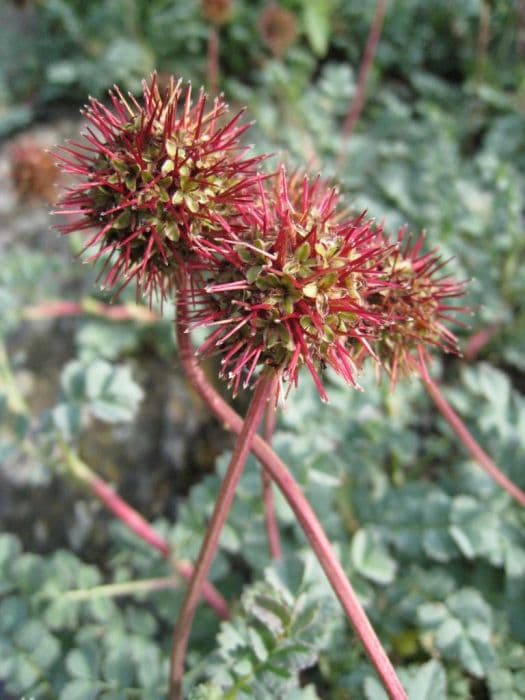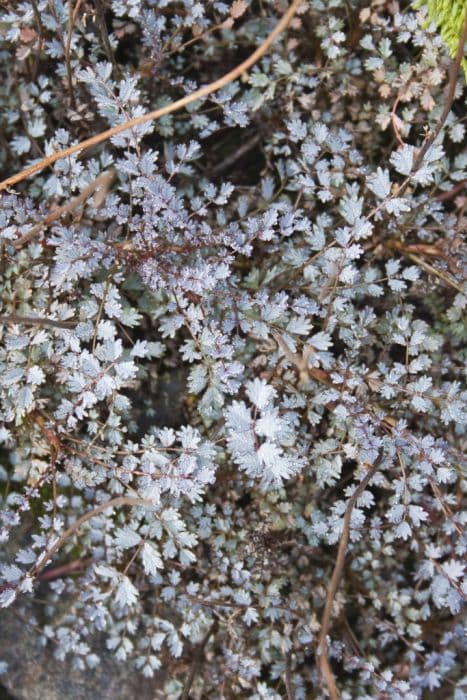Lady's Mantle Alchemilla epipsila

ABOUT
The plant commonly known as Lady's Mantle features a distinctive foliage with a soft, velvety texture and a vibrant, gentle green hue. The leaves of this plant have a unique shape; they are rounded, with deep and pronounced scalloped edges that contribute significantly to its ornamental value. This scalloping gives the leaves an almost circular appearance, and they are arranged in a basal rosette pattern, where they emerge in a circular formation directly from the root system at the base of the plant. One of the charming characteristics of Lady's Mantle is its ability to capture and hold onto dewdrops or raindrops, which can make the leaves glisten as if adorned with sparkling jewels in the right light. It's a magical sight often admired by gardeners and photographers alike. On top of its beautiful foliage, this plant also produces flowers. These bloom in clusters and are small and numerous. They appear in a delicate array in a yellow-green shade, arranged in loose sprays that hover above the foliage on slender, branching stems. The overall impression is of a frothy, airy mass of blooms that provide a light and lacy contrast to the sturdy and attractive leaves below. The flowers typically bloom in the late spring to early summer, adding a soft yet bright touch to the plant's lush greenery. Overall, Lady's Mantle is prized for its lovely foliage and subtle floral display, making it a favorite in cottage gardens, rock gardens, and borders where a touch of gentle, natural beauty is desired.
About this plant
 Names
NamesSynonyms
Alpine Lady's Mantle, Mountain Lady's Mantle, Northern Lady's Mantle
Common names
Alchemilla alpina subsp. epipsila, Alchemilla alpina var. epipsila, Alchemilla vulgaris var. epipsila.
 Toxicity
ToxicityTo humans
Alchemilla epipsila, commonly known as lady's mantle, is not known to be toxic to humans. In general, this plant is considered safe, and there have been no significant reports of poisoning or adverse effects from ingesting parts of this plant. Therefore, consuming this plant is not expected to lead to poisoning symptoms or any severe consequences related to toxicity.
To pets
Alchemilla epipsila, known as lady's mantle, does not have a reputation for being toxic to pets. It is generally considered non-toxic for animals such as cats and dogs. There are no well-documented cases of pet poisoning from ingesting lady's mantle, and it is unlikely to cause any serious health issues if consumed by pets. However, as with any non-food plant, ingestion in large quantities could potentially cause mild stomach upset due to the novelty of the plant material in an animal's diet.
 Characteristics
CharacteristicsLife cycle
Perennials
Foliage type
Deciduous
Color of leaves
Green
Flower color
Yellow
Height
1 foot (30 cm)
Spread
1 foot 6 inches (45 cm)
Plant type
Herb
Hardiness zones
3
Native area
Europe
Benefits
 General Benefits
General Benefits- Ornamental Value: Alchemilla epipsila, commonly known as lady's mantle, adds aesthetic appeal to gardens and landscapes with its attractive foliage and small, chartreuse yellow flowers.
- Drought Tolerance: Once established, lady's mantle is relatively drought tolerant, making it a suitable choice for gardens in drier climates or for xeriscaping.
- Ground Cover: The low-growing habit and spreading nature make lady's mantle an excellent ground cover, helping to suppress weeds and prevent soil erosion.
- Attracts Pollinators: The flowers of lady's mantle attract a variety of pollinators, including bees, which are essential for the pollination of many plants.
- Low Maintenance: Lady's mantle is known for being easy to care for, requiring minimal maintenance once established, which is great for gardeners looking for low-effort plants.
- Border Planting: Due to its compact size and appealing look, lady's mantle is often used for border plantings, edging, and in garden pathways.
- Culinary Use: While avoiding health-related claims, the plant has been historically used in cottage gardens and can be occasionally found in herbal teas for its mild flavor.
- Rainwater Capture: The unique shape of its leaves captures and holds dew and rainwater, which can be visually appealing in the early morning or after rainfall.
 Medical Properties
Medical Properties- Anti-inflammatory: Alchemilla epipsila has been traditionally used for its potential to reduce inflammation in various conditions.
- Wound healing: It is sometimes applied topically to assist with the healing of minor wounds due to its astringent properties.
- Menstrual aid: The plant has been used in folk medicine to help regulate menstrual cycles and relieve menstrual pain.
- Gastrointestinal relief: Herbal remedies including Alchemilla epipsila have been used to treat mild digestive disorders, such as diarrhea and gastritis.
 Air-purifying Qualities
Air-purifying QualitiesThis plant is not specifically known for air purifying qualities.
 Other Uses
Other Uses- Lady's Mantle (Alchemilla epipsila) can be used to create a natural dye for fabrics, often yielding a light green or yellow hue depending on the mordant used.
- The leaves of Lady's Mantle can be used for their water-repellent properties in creating natural coverings or as a decorative outdoor feature that beads water.
- The fine hairs on the leaves can be used in crafting, providing texture to botanical prints or nature-inspired artwork.
- The plant's ability to thrive in tough conditions makes it an excellent ground cover in garden design, offering an aesthetic green carpet with minimal maintenance.
- Lady's Mantle is used as a companion plant in gardens to attract beneficial insects that help with pollination and pest control.
- The flowers can be dried and included in potpourri mixes for a subtle fragrance and added visual appeal.
- The leaves can be pressed and included in herbarium collections for educational purposes or botanical study.
- Lady's Mantle can be used in landscape photography to provide a dewy morning effect as droplets collect on the scalloped leaves.
- The plant may be used as a biological indicator for soil pH, as it prefers slightly acidic to neutral soils, which can guide gardeners on soil adjustments.
- Finally, Lady's Mantle can be used as part of a rain garden, due to its ability to withstand and thrive in moist environments, helping with water management.
Interesting Facts
 Feng Shui
Feng ShuiThe Lady's Mantle is not used in Feng Shui practice.
 Zodiac Sign Compitability
Zodiac Sign CompitabilityThe Lady's Mantle is not used in astrology practice.
 Plant Symbolism
Plant Symbolism- Femininity: The plant's common name, Lady's Mantle, refers to the Virgin Mary’s cloak in Christian symbolism, often associated with a protective and nurturing energy likened to feminine qualities.
- Healing: Historically, Alchemilla has been used in herbal medicine, symbolizing its healing properties and the ability of nature to remedy ailments.
- Protection: The leaves of Lady’s Mantle often collect dew, which was believed by alchemists to be a pure form of water that could be used in their quest to turn base metals into gold, symbolizing protection and transformation.
- Magic and Alchemy: The name "Alchemilla" is derived from the word "alchemy," alluding to the plant's association with magical practices and the transformational processes alchemists sought to master.
- Purity: The dewdrops found on the leaves are seen as symbols of purity and the perfection of creation, relating to its mythical association with the Virgin Mary.
 Water
WaterLady's Mantle should be watered regularly, aiming for about 1 inch of water per week, either through rainfall or manual watering. It is important to let the soil dry out slightly between waterings, which encourages deeper root growth and helps prevent root rot. During dry spells, you may need to water the plant a couple of times a week to ensure it receives enough moisture. Using a watering can or hose, apply the water directly to the base of the plant, avoiding wetting the foliage to minimize the risk of fungal diseases. Adjust the frequency of watering based on weather conditions, watering more often during hot, dry periods and less during cool, wet spells.
 Light
LightLady's Mantle thrives in partial shade to full sun, but in hotter climates, it benefits from some afternoon shade to protect it from intense, direct sunlight. The ideal spot for this plant would be where it receives morning sunlight and is sheltered from the harsh afternoon sun. Bright, indirect light will also keep the plant healthy and reduce the risk of leaf scorch, especially during the peak summer months.
 Temperature
TemperatureLady's Mantle prefers moderate temperatures and can tolerate a range from approximately 30°F to 75°F. It can survive minor frosts but may suffer if temperatures drop below freezing for extended periods. The ideal temperature range for growing Lady's Mantle is between 60°F and 70°F. Protecting the plant from extreme heat and cold will ensure its longevity and vitality.
 Pruning
PruningPruning Lady's Mantle is important for maintaining its shape and encouraging healthy growth. The best time to prune is after the plant has finished flowering, typically in late summer or early fall, to remove spent flowers and any damaged or diseased foliage. Pruning can be done annually, and removing old foliage in the spring can also promote fresh, new growth.
 Cleaning
CleaningAs needed
 Soil
SoilLady's Mantle prefers moist, well-draining soil, with a soil pH range of 5.5 to 7.0. A mix of garden soil, peat moss, and perlite in equal parts creates an ideal environment for Alchemilla epipsila.
 Repotting
RepottingLady's Mantle should be repotted every 2 to 3 years to refresh the soil and prevent it from becoming compacted, which can impede drainage and root health.
 Humidity & Misting
Humidity & MistingLady's Mantle thrives in moderate to high humidity conditions, with the ideal range being 50-70%. It can adapt to lower humidity but shows optimal growth within this range.
 Suitable locations
Suitable locationsIndoor
Place in bright, indirect light and maintain moist soil.
Outdoor
Partial shade to full sun, well-draining soil, mulch to retain moisture.
Hardiness zone
3-8 USDA
 Life cycle
Life cycleAlchemilla epipsila, commonly known as Lady's Mantle, begins its life cycle as a seed, which requires a cold period to break dormancy and germinate in early spring. Upon germination, the seedling emerges and develops a rosette of rounded, palmately lobed, green leaves with a distinctive silver edging. The plant grows vegetatively, forming a clump that can spread via rhizomes. During late spring to early summer, Lady's Mantle produces small, inconspicuous, yellowish-green flowers on branching stems above the foliage. After pollination, which is often facilitated by wind or insects, the flowers develop into small fruits, each containing a single seed. The plant then enters a period of dormancy during the colder months, with the seeds overwintering to restart the cycle in the following spring.
 Propogation
PropogationPropogation time
Spring-early summer
Alchemilla epipsila, commonly known as Lady's Mantle, is usually propagated by seed or division. The most popular method of propagation for this plant is by division and is typically done in spring or early fall. To propagate by division, the gardener should carefully dig up the plant and gently separate the clumps of roots into smaller sections, each with several shoots and a portion of root. These divisions should then be replanted immediately at the same depth they were originally growing and watered thoroughly. It is important to maintain consistent moisture levels during the first few weeks after division to ensure successful establishment of the new plants.









